Rising in radiance
The creation of Brandeis' new literary magazine spotlighting students of color
For centuries, art has not merely functioned as a demonstration of aesthetics — it has served as a vital avenue for self-expression, communication and connection. If we turn to history, art has been a platform for communities of color to assert their identities and narratives in a world that often silences their voices.
The purpose of art for students of color at Brandeis cannot be overstated. For Shelley Polanco ’24, an Afro-Latina photographer and creator of the installation “La Fuerza de Brandeis: The Latinx Portrait Project,” her photography is an avenue for her to “elevate the realities that are otherwise silenced in our society.” Each portrait she takes is entirely self-determined, ensuring that our campus’s Latinx students, faculty and staff are authentically depicted as they choose to be seen.
Afro-Caribbean artist Mala Smith ’26 uses their art to explore Blackness, saying, “Blackness is so obvious that it is not stated, yet so central it shapes entire lives and narratives.” Looking at the works of these artists on our very own campus, it is clear that art serves as a tool for them to affirm their existence and experiences at a predominantly white institution.
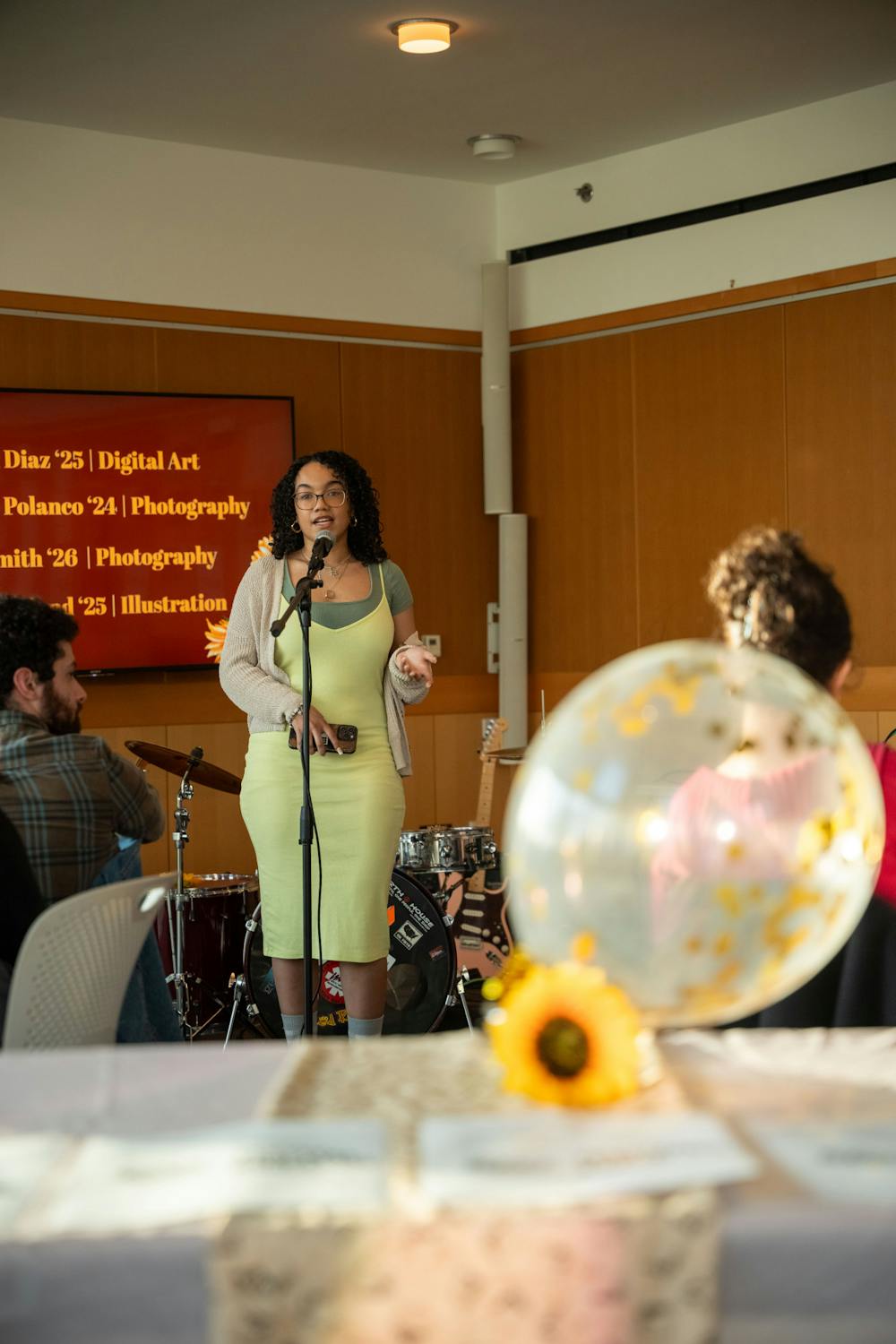
ARTIST TALKS: Shelley Polanco ’24 shares how she uses her photography as a powerful tool to spotlight the Latinx community, which is often overlooked at Brandeis.
Zaire Simmonds ’26, a student, educator and writer, uses art to share his authentic voice — which is often undermined in many spaces on campus. In a screenwriting class at Brandeis, Simmonds shared a screenplay inspired by his own life with the class for feedback. One critique he was given: the Black characters in the piece are too articulate. In response, Simmonds turned to poetry to portray no voice other than his own and no experience of his identity other than his own.
Simmonds’ experience in his screenwriting class is symptomatic of a more significant issue — the stereotypes surrounding different races confine conceptions of people of color to one specific existence. This is one of the many issues Mina Rowland ’25 and Kenyatta David ’24 hope to combat through creating the Black, Indigenous and other people of color literary magazine “RISE.” In an interview with David in anticipation of the launch of “RISE,” he shared how he hopes the art dispersed through the magazine will explore and question “the idea of race as a monolith, where specific people from specific races have to act a specific way and fit into this packed box of stereotypes and if they don’t fall into those stereotypes they aren’t ‘being what that race is supposed to be or fitting that status quo.’” Too often, people of color’s voices are disregarded by the masses if they do not conform to pre-existing expectations. David views the magazine as an opportunity to celebrate students’ authentic voices on campus, challenge the monolith perspective of race and “foster community not just in agreement, but also in disagreement.”
Although the magazine has yet to publish its first issue, on April 12, the night of the project’s launch party, the feelings of community and celebration that David and Rowland hope to foster were palpable.
Rowland and David kicked off the evening by introducing "RISE" and their vision for it. The two shared how "RISE" will celebrate the “visual legacies of people of color” from the magazines’ pages to pop-up shops and art viewings at Brandeis. In that same vein, the title of the magazine was inspired by sunflowers and their enduring ability to grow towards the sun regardless of circumstances. Rowland finished her speech with a beautiful original poem connecting the resilience of communities of color to the flower, encouraging everyone in the room to celebrate their own experiences and journeys.
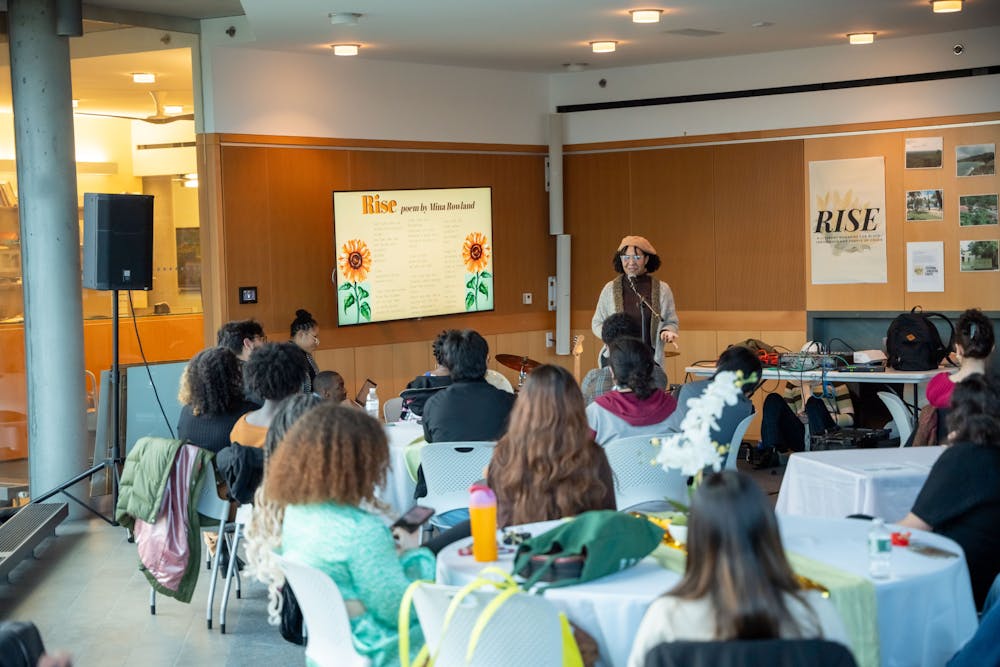
They then passed the microphones to the masters of ceremonies for the night, Micah Bryant ’26 and Nana Kudom ’27. From their entrance, Bryant and Kudom were incredibly energetic, adding to the dynamic atmosphere of the event with their infectious enthusiasm. Before the student performances began, they introduced the student artists whose photography, poetry and illustrations adorned the walls of the Mandel Center for the Humanities’ Atrium. Each student, Polanco, Smith, Rowland, Richard “Richie” Impert Jr ’24, Linet Cardoso ’26 and Samuel Diaz ’25, was given the opportunity to share a few words about themselves and their art. Diaz’s sentiment that “art is not essential to life but art makes life worth living,” touched everyone in the audience and encapsulated what art does for people from all walks of life.
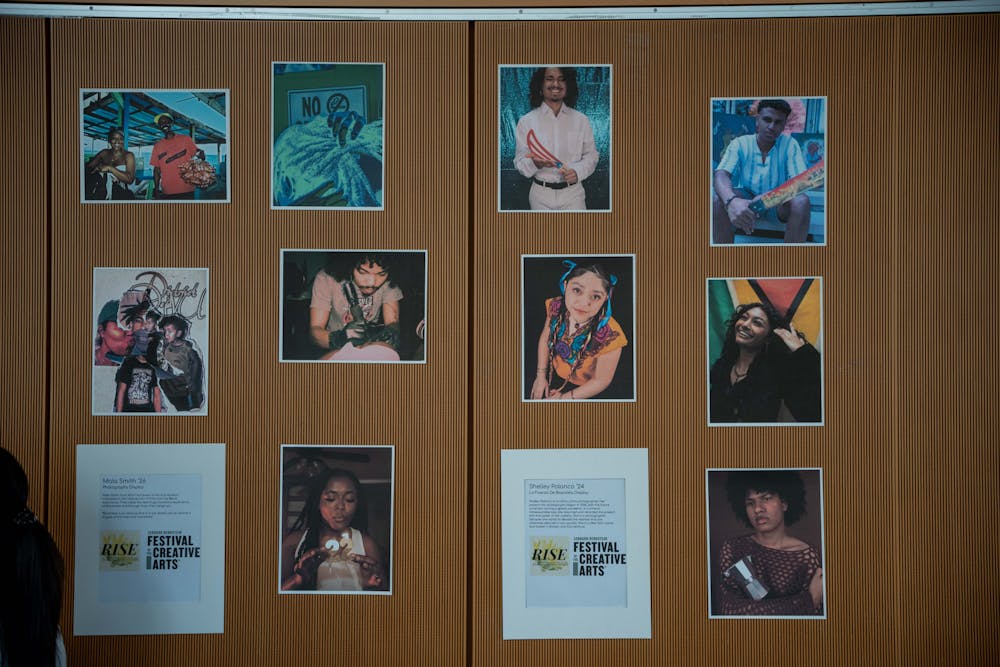
Finally, as the sun began to set, the audience cheered and snapped as the student performances began. The first reading was by Impert, a “Haitian American creative drawn to sound and emotion, [who] seeks to spread paint across canvas in his own special way.” Impert read a few pieces, including “please meet my eyes” and “Heliotropism,” which connected to how a flower learns to grow towards the sun. Particularly poignant was how Impert included Haitian Creole phrases in his poetry. For example, the title of one of Impert’s poems was “etoile sa mwen renmen,” which artistically translates to “such star i adore so” and literally translates to “that star I love.” Including these phrases in his already deeply personal pieces grounded them in his intersectional identity and history. These pieces beautifully tied in with one of David’s goals for the magazine: highlighting how “intersectionality is intersectionality because it is an array, not because it is a single line.”
Continuing with poetry, David was the next artist to take the stage. A Creative Writing major at Brandeis, David usually includes threads of Afro-realism in his work, describing his conception of the Black experience through surrealistic and fantastical elements. However, the poem he shared was a hilarious yet powerful commentary on the cult-classic film, “Dead Poets Society.” “Dead Poets Society,” to briefly summarize, explores the plights and story of a series of boys in a poetry class at an incredibly wealthy, all-white, all-male private school. Critiquing the wealth and privilege of these boys, as well as the out-of-touch nature of the film, David performed his piece, “Dead Negro Society.” A mere summary cannot encapsulate the true brilliance of the poem; however, lines slamming the characters that “fail upward in their midsummer night dream,” or state “you can’t carpe diem a money tree with a silver spoon,” highlight David’s cleverness and contrarian, yet necessary, beliefs of the widely loved film.
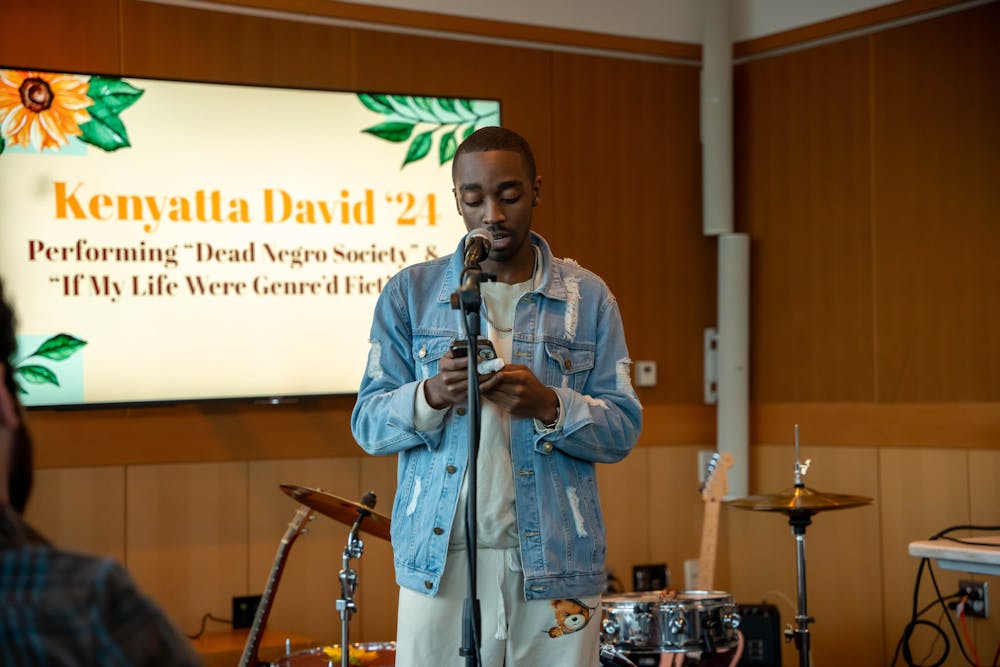
The final poet of the night was Simmonds, who recited a series of poems inspired by the coming-of-age screenplay, “Dancing with the Devil,” that he is writing about his life. As previously mentioned, the feedback Simmonds received reduced his characters to stereotypical representations of Black individuals in the media. In response, the title of each poem was a line specifically from his script. Each poem was deeply personal and an authentic representation of his voice, untouched by the perceptions and biases of others. Rowland and David realize that Simmonds’ experience in his screenwriting class was not uncommon among students of color, especially at a predominately white institution. During the interview, David mentioned, “It can be a very autonomy stripping space to be told that Blackness looks this way and so this magazine is to alleviate that and show that Blackness can look however the hell you want it to be.”
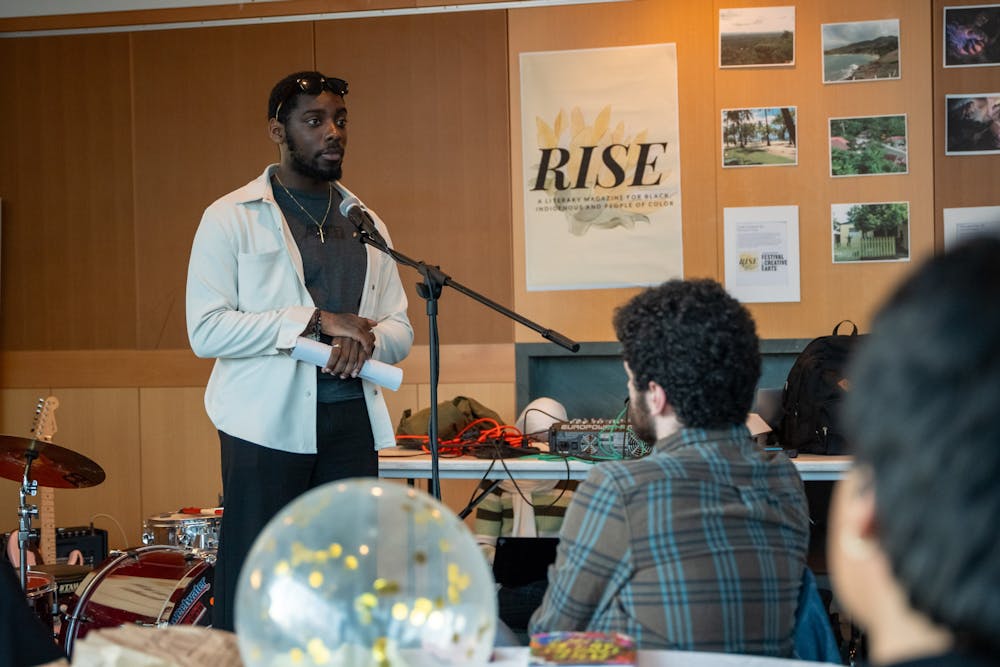
Enhancing the poetic verses with a backdrop of music, the next few performances featured a series of talented singers and songwriters. Up first was Melora Hutcheson ’25. Hutcheson, who learns music mainly by ear, performed Beyonce’s “Love Drought,” a song that reminds them of their home. Hutcheson’s voice started light and melodic, building in soul and power as the song progressed.
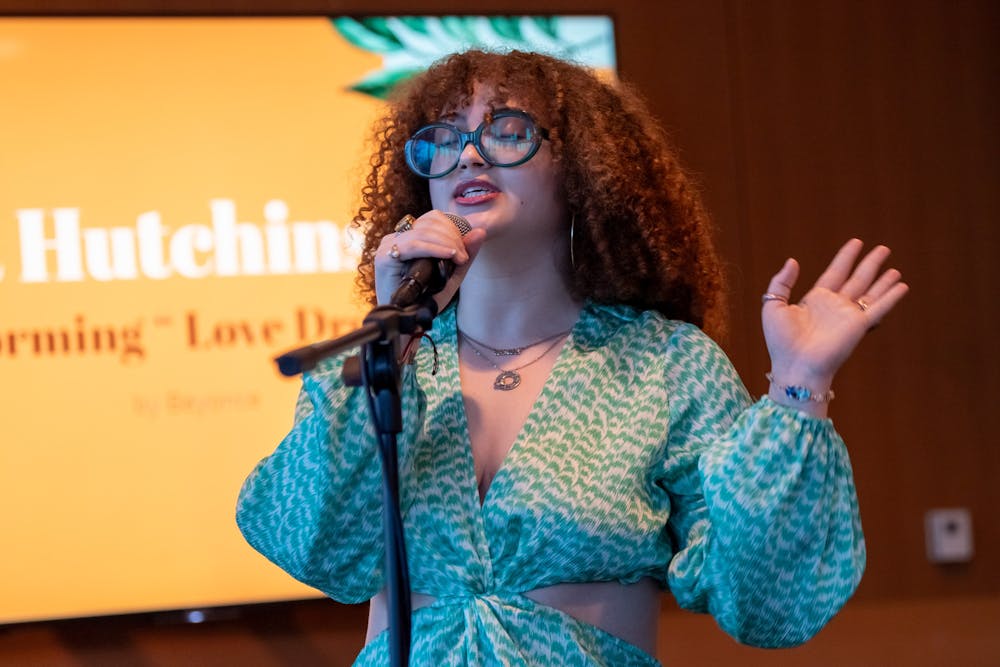
Following Hutcheson, Hannah Henris ’26 took to the “stage” to perform “On My Knees.” A singer in Midnight Groove, the rhythm and blues band that performed at Springfest the same weekend, Henris has a deep and moving voice that complements the song perfectly. She shared that she chose “On My Knees” because it gives her hope and helps her faith grow.
Transitioning from the more soulful pieces, the indie rock band “Olas de Surya” performed some of their original songs. Composed entirely of students of color, the band blends different rhythms, genres and English and Spanish. Although the entire band could not be present, lead singer Marco Ferral Hernandez ’25, guitarist Juan Jiménez ’24 and drummer Christopher Li ’24 certainly brought an infectious energy to the evening. The first song they performed was called “Otro Día,” a phrase Ferral was always told as a child. While the song was entirely in Spanish, the bouncy and light lyrics juxtaposed with the grungy riffs made the audience dance in their seats. Their next song was “Yucca,” which was much more mellow and rocky than “Otro Día,” but showcased Ferral’s raspy and powerful vocals and incredible guitar and drum solos by Jiménez and Li. The performance concluded with a chorus of cheers and applause from the room.
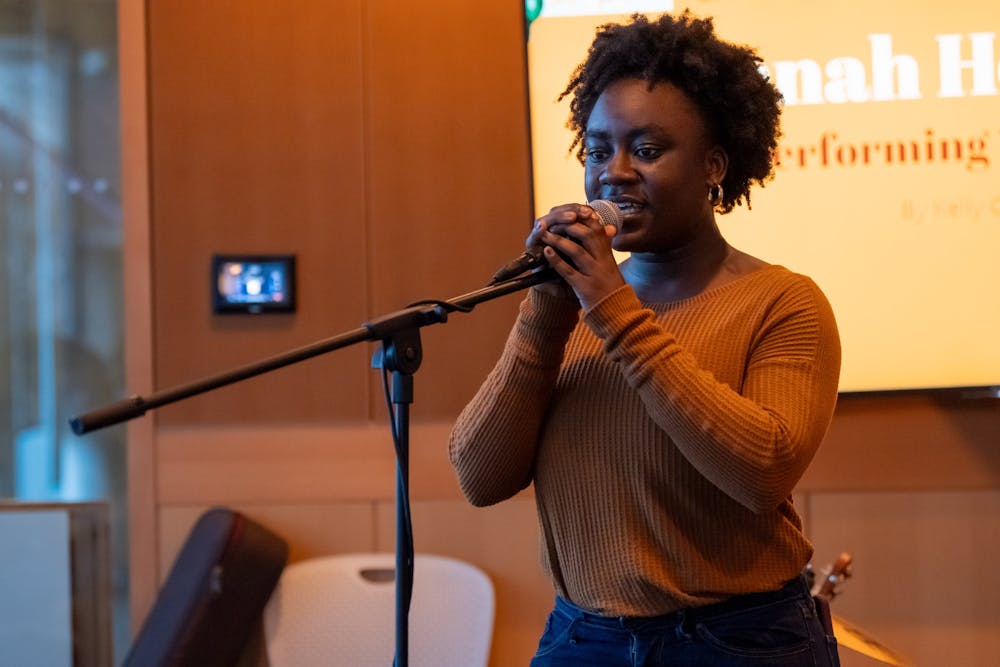
Once the live performances of the night had concluded — and everyone enjoyed a brief intermission with catered Caribbean food — the lights dimmed and the audience turned their attention to the projector to watch some short films made by student creators.
Linette Cardoso ’26, a photographer from the Dominican Republic, presented a compilation of stunning photographs she took during some of her visits to her grandparents’s home in the DR. Cardoso’s passion “lies in enhancing infrastructure and designing spaces that reflect the vibrant creativity emanating from underdeveloped nations, including her own.” Her film was a beautifully poignant illustration of the DR, and her eye for photography clearly reflects her appreciation of the country and her understanding of space and architecture.
The film portion concluded with works by Mirabell Rowland ’25, who created the documentaries “Rooted in Excellence” with Gabrielle Pile ’24 and “Black is Beautiful.” A celebration of natural hair, “Black is Beautiful” not only spotlighted Brandeis students with natural hair — filming them against a black backdrop, backlit by vibrant lights — but it explored three students’ journeys of self-love and appreciation for their hair. Through interviews with Lauryn Williams ’25, Polanco and Pile, we learned about their experiences reconciling femininity with natural hair, maintaining their hair and ultimately learning to love it. As Polanco shared in the documentary, “If people don’t have that space [for my hair], make it.”
To wrap up the event, Rowland and David offered their closing remarks, celebrating all the work and artists present and getting the audience excited about the bright future of “RISE.” In all, this was a fantastic event placing artists of color’s voices and lives in the limelight; however, the reach of “RISE” will not stop there.
During the interview with David, he discussed his hopes for the magazine’s impact on Brandeis and the broader community. At its most basic level, David is co-creating “RISE” in order to create a safe space that welcomes self-expression and exploration. Creating a safe space does not necessarily mean a space where everyone constantly sees eye to eye. Rather, he hopes to “foster a community not just in agreement, but in disagreement.” Within the club itself, students should feel free to submit any work that they feel represents themselves — whatever that means — because in disagreement there is the opportunity for learning.
With each publication, David hopes the pieces will offer an opportunity for introspection for all students at Brandeis, regardless of race or positionality. He explained, “When you have something to rattle someone’s worldview, to insert a difference in perspective, like how the magazine should or hopefully will, it makes people question themselves and in that questioning, that’s where learning and growth occurs.” When reading the works published in each issue of “RISE,” students will be exposed to an intimate understanding of different identities that other spaces at Brandeis do not necessarily offer.
On a larger scale, David hopes this magazine will branch out beyond Brandeis and become a means of interconnecting Black creatives. In serving as a foundational platform that spotlights the genuine narratives of various creators in the greater Boston area, “RISE” can become a megaphone through which creatives of color can be sure their voices are heard and respected. Especially in a small insular environment like Brandeis, which as David put it, “has a light censorship issue,” it is incredibly isolating and difficult to have an opinion or identity that does not conform with the masses. For David, the magazine is consequently “in and of itself an act of rebellion” where “you allow more autonomy than what this sort of constricting environment allows.” As Rowland and David work hard to launch the magazine and foster connections among BIPOC creatives, “RISE” will not only ensure all narratives, like the sunflowers that inspired them, are able to come to light and stand as a testament to the transformative power of community and storytelling.
— Editor’s Note: Justice Associate Editor Mina Rowland ’25 is the co-creator of “RISE” and did not contribute to or edit this article in any way.
— Editor’s Note: Justice Deputy Editor Lauryn Williams ’25 was interviewed for the documentary “Black is Beautiful,” and did not contribute to or edit this article in any way.

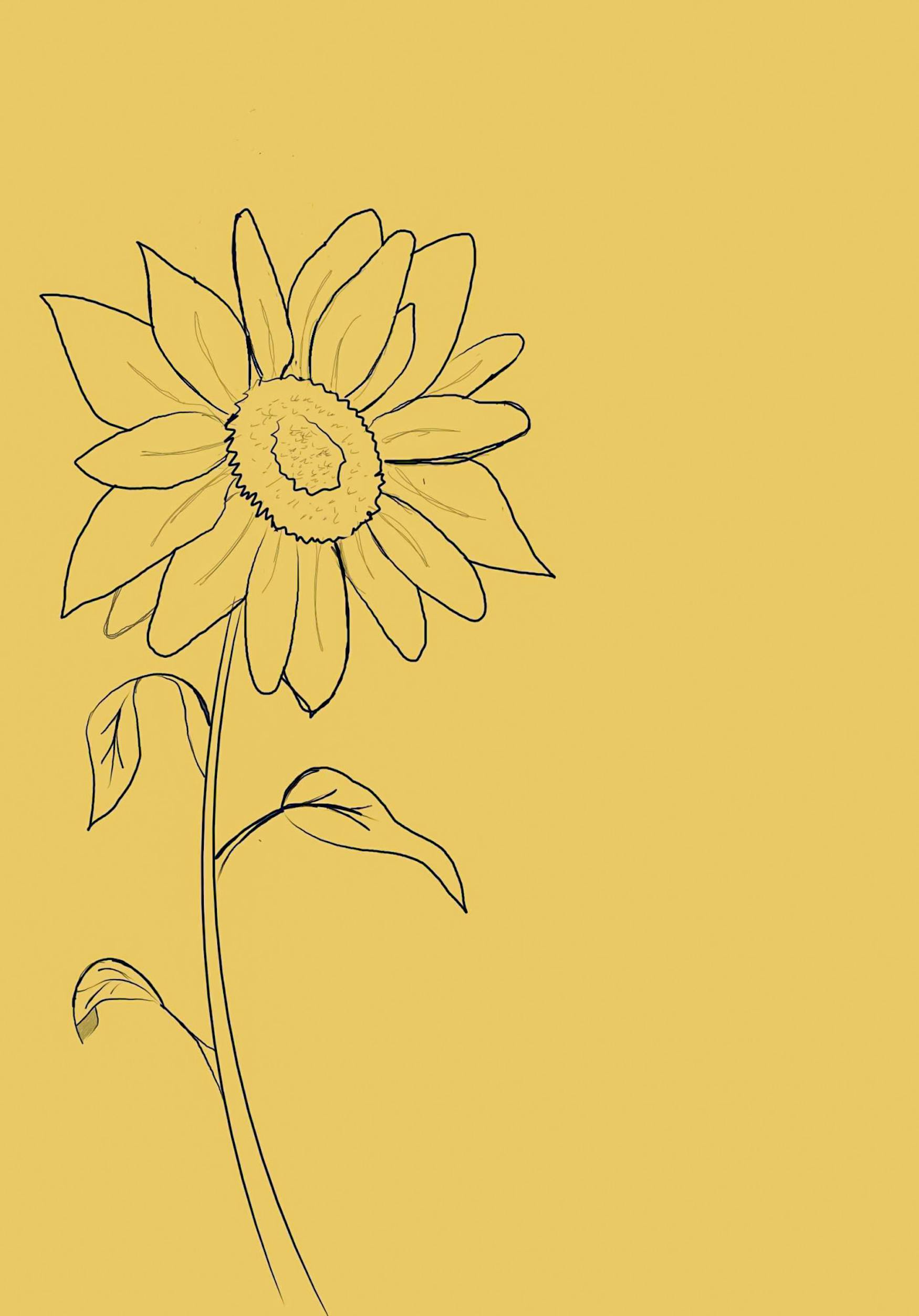

Please note All comments are eligible for publication in The Justice.